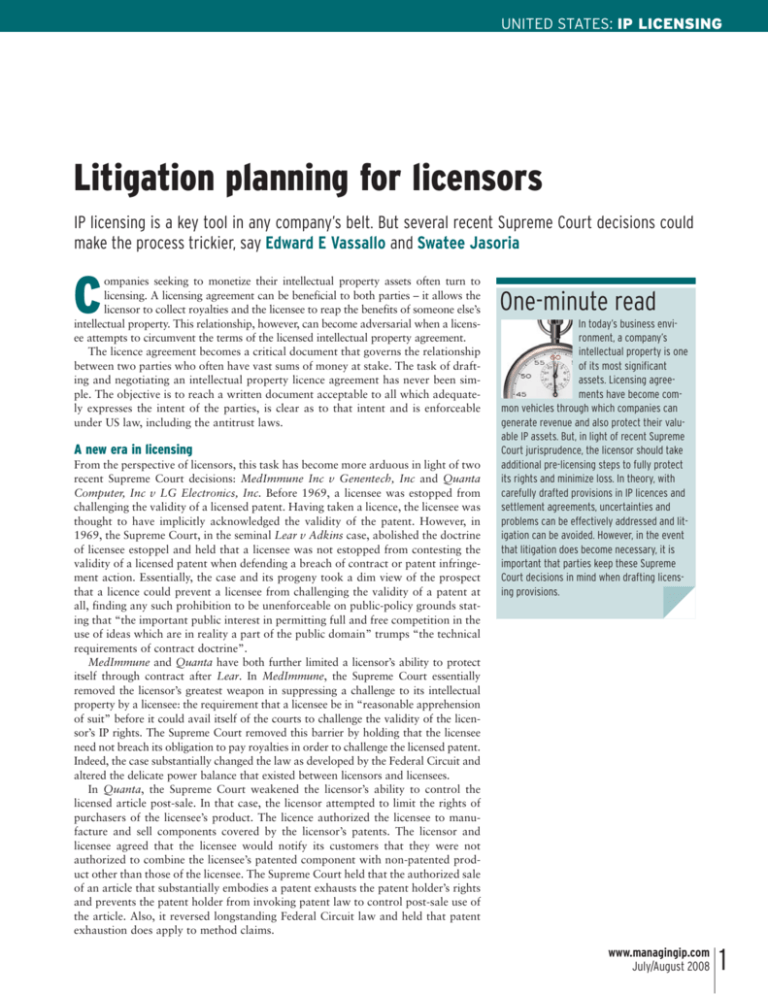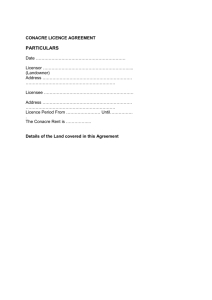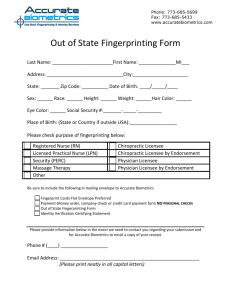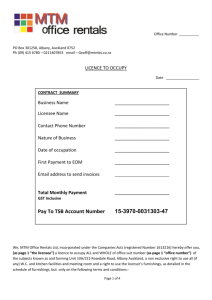View Attachment - Fitzpatrick, Cella, Harper & Scinto
advertisement

UNITED STATES: IP LICENSING Litigation planning for licensors IP licensing is a key tool in any company’s belt. But several recent Supreme Court decisions could make the process trickier, say Edward E Vassallo and Swatee Jasoria C ompanies seeking to monetize their intellectual property assets often turn to licensing. A licensing agreement can be beneficial to both parties – it allows the licensor to collect royalties and the licensee to reap the benefits of someone else’s intellectual property. This relationship, however, can become adversarial when a licensee attempts to circumvent the terms of the licensed intellectual property agreement. The licence agreement becomes a critical document that governs the relationship between two parties who often have vast sums of money at stake. The task of drafting and negotiating an intellectual property licence agreement has never been simple. The objective is to reach a written document acceptable to all which adequately expresses the intent of the parties, is clear as to that intent and is enforceable under US law, including the antitrust laws. A new era in licensing From the perspective of licensors, this task has become more arduous in light of two recent Supreme Court decisions: MedImmune Inc v Genentech, Inc and Quanta Computer, Inc v LG Electronics, Inc. Before 1969, a licensee was estopped from challenging the validity of a licensed patent. Having taken a licence, the licensee was thought to have implicitly acknowledged the validity of the patent. However, in 1969, the Supreme Court, in the seminal Lear v Adkins case, abolished the doctrine of licensee estoppel and held that a licensee was not estopped from contesting the validity of a licensed patent when defending a breach of contract or patent infringement action. Essentially, the case and its progeny took a dim view of the prospect that a licence could prevent a licensee from challenging the validity of a patent at all, finding any such prohibition to be unenforceable on public-policy grounds stating that “the important public interest in permitting full and free competition in the use of ideas which are in reality a part of the public domain” trumps “the technical requirements of contract doctrine”. MedImmune and Quanta have both further limited a licensor’s ability to protect itself through contract after Lear. In MedImmune, the Supreme Court essentially removed the licensor’s greatest weapon in suppressing a challenge to its intellectual property by a licensee: the requirement that a licensee be in “reasonable apprehension of suit” before it could avail itself of the courts to challenge the validity of the licensor’s IP rights. The Supreme Court removed this barrier by holding that the licensee need not breach its obligation to pay royalties in order to challenge the licensed patent. Indeed, the case substantially changed the law as developed by the Federal Circuit and altered the delicate power balance that existed between licensors and licensees. In Quanta, the Supreme Court weakened the licensor’s ability to control the licensed article post-sale. In that case, the licensor attempted to limit the rights of purchasers of the licensee’s product. The licence authorized the licensee to manufacture and sell components covered by the licensor’s patents. The licensor and licensee agreed that the licensee would notify its customers that they were not authorized to combine the licensee’s patented component with non-patented product other than those of the licensee. The Supreme Court held that the authorized sale of an article that substantially embodies a patent exhausts the patent holder’s rights and prevents the patent holder from invoking patent law to control post-sale use of the article. Also, it reversed longstanding Federal Circuit law and held that patent exhaustion does apply to method claims. One-minute read In today’s business environment, a company’s intellectual property is one of its most significant assets. Licensing agreements have become common vehicles through which companies can generate revenue and also protect their valuable IP assets. But, in light of recent Supreme Court jurisprudence, the licensor should take additional pre-licensing steps to fully protect its rights and minimize loss. In theory, with carefully drafted provisions in IP licences and settlement agreements, uncertainties and problems can be effectively addressed and litigation can be avoided. However, in the event that litigation does become necessary, it is important that parties keep these Supreme Court decisions in mind when drafting licensing provisions. www.managingip.com July/August 2008 1 UNITED STATES: IP LICENSING The trend in Supreme Court jurisprudence has continued to fundamentally alter the licensor/licensee dynamic in favour of the licensee: licensors are the clear losers in light of Lear, MedImmune, and Quanta. Thus, licensors should take prelicensing steps to fully protect their rights and minimize loss, since, even with careful drafting, litigation is not always avoidable. Through careful drafting of the licence agreement, vigilant pre-licence negotiations and an adjustment of the licensors’ objectives, prospective licensors can improve their position should a dispute arise. a patentee might, at the outset of negotiation, require a prospective licensee to execute a confidentiality agreement. Even better, a patentee might insist that the negotiation be conducted pursuant to Federal Rule of Evidence 408, which may render evidence generated in connection with settlement negotiations inadmissible in court. These steps will serve to minimize the risk that during negotiations, disagreements that occur will establish declaratory judgment jurisdiction, and that the concessions made by the patentee will be admissible “admissions” in litigation. Lear may not extend to other forms of IP Do your due diligence; adjust your negotiations strategy Historically, licensors have attempted to contract away the licensee’s ability to challenge the validity of the underlying intellectual property through the use of “no contest” clauses. Although Lear and its progeny eliminated this possibility in licences of US patents, it does not necessarily extend to other forms of intellectual property. Judicial enforcement of the “no contest” clauses differs depending on the type of intellectual property. Since MedImmune and SanDisk make it clear that a potential patent licensor may be sued if negotiations fail, the licensor should do pre-suit due diligence before commencing negotiations. Also, a potential patent licensor may wish to consider these: 1) Acknowledgement of need: the prospective licensor should consider insisting that the prospective licensee acknowledge, in the agreement, the validity of the patent, and its infringement but for a licence. While these provisions will not prevent a licensee from challenging the licensed intellectual property, they may serve as powerful admissions at trial. 2) Pre-emptive litigation: while this approach is hardly conducive to non-adversarial negotiations, prospective licensees will begin to understand why a licensor opts for this approach. The licensor will have secured its choice of venue, and can delay service of the complaint for 120 days to delay commencement of the litigation process, while the parties negotiate a licence. Moreover, if agreement is reached, the licensor may want to treat it as a settlement agreement or a part of a consent judgment, so that principles of res judicata and collateral estoppel, principles that prevent re-litigation between the same parties, may “trump” the Lear doctrine. 3) Risky royalties: the prospective licensor may want to request a royalty rate increase if the licensee does challenge the licensed intellectual property, but fails in the challenge. Also, the licensor may want a provision that the prevailing party in such a suit shall receive its attorneys’ fees from the other. Copyright licences Courts have held that a “no contest” clause in a copyright licence agreement is valid unless the agreement is shown to violate antitrust law. They have stated that if a particular clause is used to confer monopoly power beyond the “small amount” that the copyright laws authorize, then the clause can be attacked under Section 1 of the Sherman Act as a restraint of trade. This result is different from the per se prohibition in Lear because a copyright empowers its owner to prevent others from copying only the particular verbal, pictorial, or aural pattern in which the owner chooses to express himself. In other words, the economic power conferred by copyright protection is smaller. Trade mark licences Generally, a “no contest” clause in a trade mark licence agreement has been determined to be enforceable. Courts have held that a party to an agreement with respect to a trade mark will be held to its contract unless enforcement would result in injury to the public through confusion. There is however a split as to whether a licensee can challenge the validity of a licensed trade mark due to licensor’s alleged failure to adequately monitor quality of other licensee’s goods. Strategies post-MedImmune Avoid infringement accusations The most obvious strategy for circumventing MedImmune is for the licensor to avoid the possibility of being sued. The licensor’s approach should be vague: he should use language that focuses on the freedom, competitive advantage and enhanced value a licence will confer and avoid asserting that any particular activity or product of the prospective licensee requires a licence. By being vague, the licensor may avoid generating a justiciable controversy between the parties, thereby depriving courts of jurisdiction should negotiations prove unsuccessful. Keep it confidential The Federal Circuit recently suggested in SanDisk Corp v STMicroelectronics, a case which followed MedImmune, that 2 www.managingip.com July/August 2008 Strategies post-Quanta The Quanta decision suggests that a patent licensor should consider larger up-front royalties in exchange for broader licences, as downstream revenue opportunities may be barred by patent exhaustion. If downstream revenue is the preferred route, then the patent licence must set express conditions limiting the sale by the licensee, as opposed to mere “notice” to customers of the licensee as to what they may or may not do with licensee’s products. Similarly, the patentee can no longer rely on the presence of method claims in the licensed patent to control downstream royalties. Edward E Vassallo Swatee Jasoria © Edward E Vassallo and Swatee Jasoria 2008. Vasallo is a partner and Jasoria is an associate at Fitzpatrick Cella Harper & Scinto


